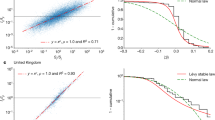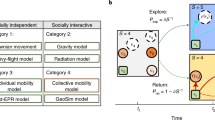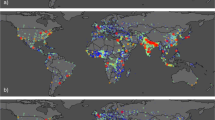Abstract
Contemporary literature on the dynamics of economic activities in growing cities has mainly focused on time frames of a few years or decades. Using a new geohistorical database constructed from historical directories with about 1 million entries, we present a comprehensive analysis of the dynamics of activities in a major city, Paris, over almost a century (1829–1907). Our analysis suggests that activities that accompany city growth can be classified in different categories according to their dynamics and their scaling with population: (1) linear for everyday needs of residents (food stores, clothing retailers, health care practitioners), (2) sublinear for public services (legal, administrative, educational) and (3) superlinear for the city’s specific features (passing fads, specialization, timely needs). The dynamics of these activities is in addition very sensitive to historical perturbations such as large-scale public works or political conflicts. These results shed light on the evolution of activities, a crucial component of growing cities.
This is a preview of subscription content, access via your institution
Access options
Access to this article via ICE Institution of Civil Engineers is not available.
Subscribe to this journal
Receive 12 digital issues and online access to articles
$119.00 per year
only $9.92 per issue
Buy this article
- Purchase on SpringerLink
- Instant access to full article PDF
Prices may be subject to local taxes which are calculated during checkout



Similar content being viewed by others
Data availability
The dataset of the population censuses of Paris at the scale of districts between 1801 and 1911 is openly accessible with the documentation on the Nakala platform of the CNRS Research Infrastructure Huma-Num at https://doi.org/10.34847/nkl.e173c93p. The dataset of Paris directories entries with NAICS-inspired categories between 1829 and 1907 specifically constructed and used for this paper is openly accessible on the Zenodo platform https://doi.org/10.5281/zenodo.8388101 (ref. 68).
Code availability
The open repository https://doi.org/10.5281/zenodo.8388101 (ref. 68) contains the code to create the figures and tables of both the main text and the Supplementary Information.
References
Batty, M. The New Science of Cities (MIT Press, 2013).
Barthelemy, M. The Structure and Dynamics of Cities (Cambridge Univ. Press, 2016).
Bettencourt, L. M. A. Introduction to Urban Science: Evidence and Theory of Cities as Complex Systems (MIT Press, 2021).
Duranton, G. & Puga, D. in Handbook of Economic Growth Vol. 2 (eds Aghion, P. & Durlauf, S. N.) 781–853 (Elsevier, 2014).
Pumain, D., Paulus, F., Vacchiani-Marcuzzo, C. & Lobo, J. An evolutionary theory for interpreting urban scaling laws. CyberGeo: Eur. J. Geogr. https://doi.org/10.4000/cybergeo.2519 (2006).
Henderson, J. V. & Wang, H.-G. Urbanization and city growth: the role of institutions. Reg. Sci. Urban Econ. 37, 283–313 (2007).
Verbavatz, V. & Barthelemy, M. The growth equation of cities. Nature 587, 397–401 (2020).
Beeson, P. E., DeJong, D. N. & Troesken, W. Population growth in U.S. counties, 1840-1990. Reg. Sci. Urban Econ. 31, 669–699 (2001).
Ortman, S. G., Cabaniss, A. H. F., Sturm, J. O. & Bettencourt, L. M. A. The pre-history of urban scaling. PLoS ONE https://doi.org/10.1371/journal.pone.00879 (2014).
Ortman, S. G., Lobo, J. & Smith, M. E. Cities: complexity, theory and history. PLoS ONE https://doi.org/10.1371/journal.pone.0243621 (2020).
Lobo, J., Bettencourt, L. M. A., Smith, M. E. & Ortman, S. Settlement scaling theory: bridging the study of ancient and contemporary urban systems. Urban Stud. 57, 731–747 (2020).
Perret, J., Gribaudi, M. & Barthelemy, M. Roads and cities of 18th century france. Sci. Data 2, 150048 (2015).
El Gouj, H., Rincón-Acosta, C. & Lagesse, C. Urban morphogenesis analysis based on geohistorical road data. Appl. Netw. Sci. 7, 6 (2022).
Bretagnolle, A., Delisle, F., Mathian, H. & Vatin, G. Urbanization of the United States over two centuries: an approach based on a long-term database (1790–2010). Int. J. Geogr. Inf. Sci. 29, 850–867 (2015).
Burghardt, K., Uhl, J. H., Lerman, K. & Leyk, S. Analyzing urban scaling laws in the United States over 115 years. Environ. Plan. B: Urban Anal. City Sci. https://doi.org/10.1177/23998083241240 (2024).
Rodriguez, N. P. & Feagin, J. R. Urban specialization in the world-system: an investigation of historical cases. Urban Aff. Q. 22, 187–220 (1986).
GeoHistoricalData. Annuaires historiques parisiens, 1798–1914. Extraction structurée et géolocalisée à l’adresse des listes nominatives par ordre alphabétique et par activité dans les volumes numérisés. NAKALA https://doi.org/10.34847/nkl.98eem49t (2023).
Barthelemy, M., Bordin, P., Berestycki, H. & Gribaudi, M. Self-organization versus top-down planning in the evolution of a city. Sci. Rep. 3, 2153 (2013).
Pumain, D. Scaling Laws and Urban Systems. Working Paper 002 (Santa Fe Institute, 2004).
Bettencourt, L. M. A., Lobo, J., Helbing, D., Kühnert, C. & West, G. B. Growth, innovation, scaling, and the pace of life in cities. Proc. Natl Acad. Sci. USA 104, 7301–7306 (2007).
Bokányi, E., Szállási, Z. & Vattay, G. Universal scaling laws in metro area election results. PLoS ONE https://doi.org/10.1371/journal.pone.0192913 (2018).
Depersin, J. & Barthelemy, M. From global scaling to the dynamics of individual cities. Proc. Natl Acad. Sci. USA 115, 2317–2322 (2018).
Keuschnigg, M. Scaling trajectories of cities. Proc. Natl Acad. Sci. USA 116, 13759–13761 (2019).
Bettencourt, L. M. A. et al. The interpretation of urban scaling analysis in time. J. R. Soc. Interface 17, 20190846 (2020).
Cristofoli, P. & Gravier, J. Populations of Paris districts (1801–1911). NAKALA https://doi.org/10.34847/nkl.e173c93p (2023).
Ignazzi, C. A. Coevolution in the Brazilian System of Cities. PhD thesis, Paris 1 Panthéon-Sorbonne University, Paris (2015).
Finance, O. & Swerts, E. in Theories and Models of Urbanization: Geography, Economics and Computing Sciences Lecture Notes in Morphogenesis (ed. Pumain, D.) 67–96 (Springer International Publishing, 2020).
Stephan, G. E. Territorial division: the least-time constraint behind the formation of subnational boundaries. Science 196, 523–524 (1977).
Gusein-Zade, S. M. Bunge’s problem in central place theory and its generalizations. Geogr. Anal. 14, 246–252 (1982).
Gastner, M. T. & Newman, M. E. J. Optimal design of spatial distribution networks. Phys. Rev. E 74, 016117 (2006).
Um, J., Son, S.-W., Lee, S.-I., Jeong, H. & Kim, B.-J, Scaling laws between population and facility densities. Proc. Natl Acad. Sci. USA 106, 14236–14240 (2009).
Nourrisson, D. Sociabilités du vin. in Une histoire du vin (ed. Nourrisson, D.) 197–240 (Perrin, 2017).
Husson, A. La consommation du lait à Paris. J. Soc. Stat. Paris 16, 17–23 (1875).
Batty, M. Rank clocks. Nature 444, 592–596 (2006).
Jordan, D. P. Transforming Paris: The Life and Labors of Baron Haussmann (Univ. Chicago Press, 1995).
Panerai, P., Castex, J., Depaule, J.-C. Urban Forms: The Death and Life of the Urban Block (ed. Samuels, I., trans. Vitale Samuels, O.) (Architectural Press, 2004).
Faure, A. Spéculation et société: les grands travaux à Paris au XIXe siècle. Hist. Econ. Soc. 23, 433–448 (2004).
Berry, B. J. L. Cities as systems within systems of cities. Pap. Reg. Sci. Assoc. 13, 146–163 (1964).
Pumain, D. From networks of cities to systems of cities. in Handbook of Cities and Networks (eds. Neal, Z. P. & Rozenblat C.) 16–40 (Edward Elgar Publishing, 2021).
Abadie, N., Carlinet, E., Chazalon, J. & Duménieu, B. A in Document Analysis Systems Lecture Notes in Computer Science (eds Uchida, S. et al.) 445–460 (Springer International Publishing, 2022).
Cura, R. et al. Historical collaborative geocoding. ISPRS Int. J. Geo-Inf. 7, 1–29 (2018).
Tudesq, A.-J. Sur l'histoire sociale du XIXe siècle : Les listes électorales de la Monarchie censitaire. Annales. Hist. Sci. Soc. 13, 277–288 (1958).
Cottineau, C., Hatna, E., Arcaute, E. & Batty, M. Diverse cities or the systematic paradox of Urban Scaling Laws. Comput. Environ. Urban Syst. 63, 80–94 (2016).
Montel, N. in Agrandir Paris (1860–1970), Histoire Contemporaine (eds. Bourillon, F. & Fourcaut, A.) 99–111 (Éditions de la Sorbonne, 2012)
Ignazzi, C. A. Scaling laws, economic growth, education and crime: evidence from Brazil. Espace Géogr. 43, 324–337 (2014).
Condé, G. Mutations du système de villes belges. Cybergeo: Eur. J. Geog. https://doi.org/10.4000/cybergeo.26691 (2015).
Paulus, F. & Vacchiani-Marcuzzo, C. in Knowledge-Creating Milieus in Europe: Firms, Cities, Territories (eds Cusinato, A. & Philippopoulos-Mihalopoulos, A.) 157–170 (Springer, 2016).
Meirelles, J. et al. Evolution of urban scaling: evidence from Brazil. PLoS ONE https://doi.org/10.1371/journal.pone.0204574 (2018).
Goncalves, A. & Domingos, T. Scaling laws and electricity consumption in cities: a sectoral view. Int. J. Sustain. Energy Plan. Manag. 2, 19–32 (2014).
Xu, G., Zhou, Z., Jiao, L., Dong, T. & Ruiqi, L. Cross-sectional urban scaling fails in predicting temporal growth of cities. Preprint at https://arxiv.org/abs/1910.06732 (2019).
Hong, I., Frank, M. R., Rahwan, I., Jung, W.-S. & Youn, H. The universal pathway to innovative urban economies. Sci. Adv. https://doi.org/10.1126/sciadv.aba4934 (2020).
Ribeiro, F. L., Meirelles, J., Netto, V. M., Neto, C. R. & Baronchelli, A. On the relation between transversal and longitudinal scaling in cities. PLoS ONE 15, e0233003 (2020).
Xu, G. et al. Scaling laws in intra-urban systems and over time at the district level in Shanghai, China. Phys. A: Stat. Mech. Appl. 560, 125162 (2020).
Maisonobe, M. in Handbook Bibliometrics (ed. Ball, R.) 377–396 (De Gruyter Saur, 2020).
Andersson, D. E., Andersson, A. E., Harsman, Björn & Yang, X. The geography of science in 12 European countries: a NUTS2-level analysis. Scientometrics 124, 1099–1125 (2020).
Arvidsson, M., Lovsjö, N. & Keuschnigg, M. Urban scaling laws arise from within-city inequalities. Nat. Hum. Behav. 7, 365–374 (2023).
Lei, W., Jiao, L., Xu, G. & Zhou, Z. Urban scaling in rapidly urbanising China. Urban Stud. 59, 1889–1908 (2022).
Curado, A., Damásio, B., Encarnação, S., Candia, C. & Pinheiro, F. L. Scaling behavior of public procurement activity. PLoS ONE https://doi.org/10.1371/journal.pone.0260806 (2021).
Strumsky, D., Lobo, J. & Mellander, C. As different as night and day: scaling analysis of Swedish urban areas and regional labor markets. Environ. Plan. B: Urban Anal. City Sci. 48, 231–247 (2021).
Ortman, S. G. et al. Settlement scaling and economic change in the Central Andes. J. Archaeol. Sci. 73, 94–106 (2016).
Cesaretti, R., Lobo, J., Bettencourt, L. M. A., Ortman, S. G. & Smith, M. E. Population-area relationship for Medieval European cities. PLoS ONE https://doi.org/10.1371/journal.pone.0162678 (2016).
Ortman, S. G., Smith, M. E., Lobo, J. & Bettencourt, L. M. A. Why archaeology is necessary for a theory of urbanization. J. Urban Archaeol. 1, 151–167 (2020).
Hanson, J. W., Ortman, S. G. & Lobo, J. Urbanism and the division of labour in the Roman Empire. J. R. Soc. Interface 14, 20170367 (2017).
Hanson, J. W., Ortman, S. G., Bettencourt, L. M. A. & Mazur, L. C. Urban form, infrastructure and spatial organisation in the Roman Empire. Antiquity 93, 702–718 (2019).
Altaweel, M. & Palmisano, A. Urban and transport scaling: Northern Mesopotamia in the Late Chalcolithic and Bronze Age. J. Archaeol. Method Theory 26, 943–966 (2019).
Cesaretti, R., Lobo, J., Bettencourt, L. M. A. & Smith, M. E. Increasing returns to scale in the towns of early Tudor England. Hist. Meth. A J. Quant. Interdiscip. Hist. 53, 147–165 (2020).
Smith, M. E. et al. The low-density urban systems of the classic period Maya and Izapa: insights from settlement scaling theory. Lat. Am. Antiq. 32, 120–137 (2021).
Gravier, J. Dataset and data analysis of activities of Paris between 1829 and 1907. Zenodo https://doi.org/10.5281/zenodo.8388101 (2023).
Acknowledgements
We thank N. Abadie, S. Baciocchi, P. Cristofoli, B. Duménieu, E. Carlinet, J. Chazalon and J. Perret, who set up the processing chain enabling the extraction and enrichment of Paris directories, and without whom this work would not have been possible. This research was funded by ANR SoDUCo Program, grant number ANR-18-CE38-0013 (J.G. and M.B.).
Author information
Authors and Affiliations
Contributions
J.G. and M.B. designed the study. J.G. worked on the data and analyzed it. J.G. and M.B. wrote the paper.
Corresponding author
Ethics declarations
Competing interests
The authors declare no competing interests.
Peer review
Peer review information
Nature Cities thanks Cécile Tannier and the other, anonymous, reviewer(s) for their contribution to the peer review of this work.
Additional information
Publisher’s note Springer Nature remains neutral with regard to jurisdictional claims in published maps and institutional affiliations.
Supplementary information
Supplementary Information
Figs. 1–10 and Tables 1–4.
Rights and permissions
Springer Nature or its licensor (e.g. a society or other partner) holds exclusive rights to this article under a publishing agreement with the author(s) or other rightsholder(s); author self-archiving of the accepted manuscript version of this article is solely governed by the terms of such publishing agreement and applicable law.
About this article
Cite this article
Gravier, J., Barthelemy, M. A typology of activities over a century of urban growth. Nat Cities 1, 567–575 (2024). https://doi.org/10.1038/s44284-024-00108-7
Received:
Accepted:
Published:
Issue Date:
DOI: https://doi.org/10.1038/s44284-024-00108-7



